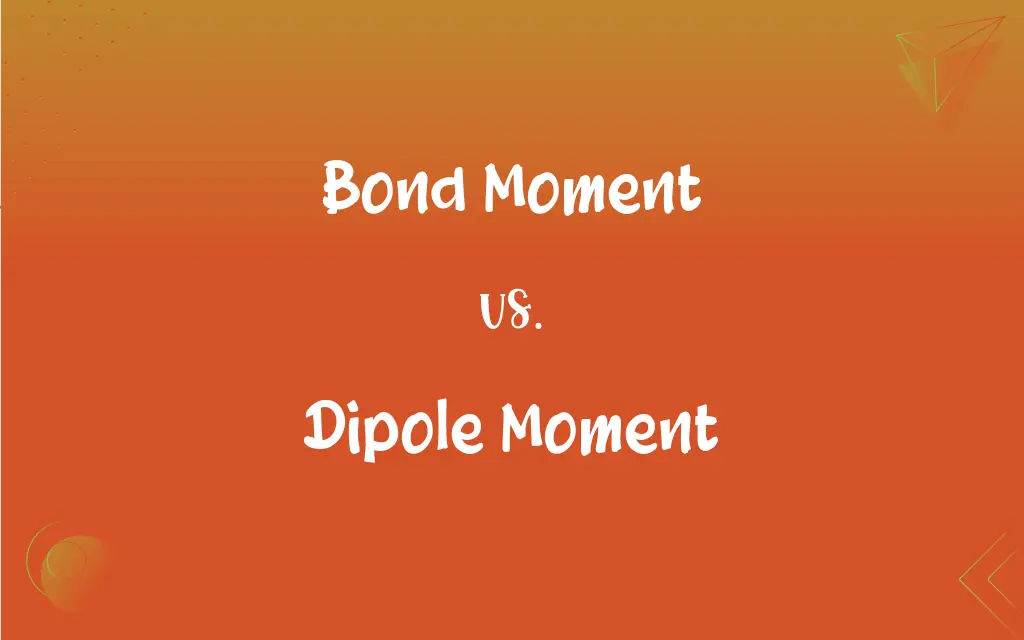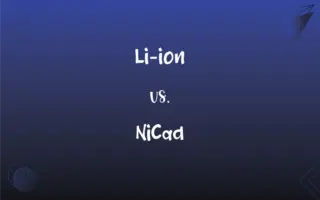Bond Moment vs. Dipole Moment: What's the Difference?
By Janet White || Published on March 18, 2024
Bond moment refers to the polarity of a single bond, while dipole moment measures the overall polarity of a molecule.

Key Differences
Bond moment, also known as bond dipole moment, is a vector quantity that describes the polarity of a chemical bond between two atoms. It is determined by the difference in electronegativity between the two atoms and the distance between their nuclei. The greater the difference in electronegativity, the more polarized the bond and the higher the bond moment. Dipole moment, on the other hand, is a measure of the overall polarity of a molecule, taking into account all the bond moments within the molecule and their spatial arrangement. It is represented as a vector quantity pointing from the positive to the negative center of charge.
The calculation and representation of bond moments involve the product of the charge difference and the distance between the atoms, typically expressed in Debye units (D). Similarly, the overall dipole moment of a molecule is calculated by vector addition of its bond moments, which can also be expressed in Debye units.
Understanding both bond moments and dipole moments is crucial in predicting the behavior of molecules in electric fields, their interactions with other molecules, and their solubility in different solvents. For instance, molecules with higher dipole moments are generally more soluble in polar solvents due to their ability to engage in dipole-dipole interactions.
Despite their interrelatedness, the distinction between bond moment and dipole moment is important for comprehensively understanding molecular polarity and its implications on chemical properties and reactions. The bond moment provides insight into the polarity of individual bonds, while the dipole moment gives a holistic view of the molecule's overall polarity.
Comparison Chart
Definition
Polarity of a single bond.
Overall polarity of a molecule.
ADVERTISEMENT
Determined By
Difference in electronegativity between two atoms and distance between their nuclei.
The sum of all bond moments and their arrangement in space.
Representation
Vector pointing from less electronegative atom to more electronegative atom.
Vector pointing from positive to negative center of charge.
Units
Debye (D)
Debye (D)
Influence on Properties
Indicates polarity of individual bonds.
Affects molecular interactions, solubility, and behavior in electric fields.
Bond Moment and Dipole Moment Definitions
Bond Moment
Influences bond's chemical behavior.
The bond moment affects how a bond will react in an electric field.
ADVERTISEMENT
Dipole Moment
Influences physical properties.
Molecules with high dipole moments tend to have higher boiling points.
Bond Moment
Vector quantity.
The direction of the bond moment vector points from the less to the more electronegative atom.
Dipole Moment
Measure of a molecule's overall polarity.
Water has a high dipole moment due to its bent shape and polar O-H bonds.
Bond Moment
Dependent on electronegativity difference.
A greater bond moment occurs when electronegativity difference between bonded atoms increases.
Dipole Moment
Dependent on molecular geometry.
The linear geometry of CO2 leads to its zero dipole moment despite polar C=O bonds.
Bond Moment
Localized within a molecule.
Analyzing bond moments helps understand localized charges within complex molecules.
Dipole Moment
Results from the vector sum of bond moments.
The dipole moment in CO2 is zero because the bond moments cancel out.
Bond Moment
Measure of a single bond's polarity.
The bond moment in an HCl molecule indicates the electron density closer to Cl.
Dipole Moment
Indicative of molecular interactions.
A molecule's dipole moment affects its solubility in polar solvents.
FAQs
How does molecular geometry affect the dipole moment?
The spatial arrangement of bonds in a molecule can enhance or negate the individual bond moments, directly influencing the overall dipole moment.
Why do molecules with higher dipole moments have higher boiling points?
Molecules with higher dipole moments have stronger dipole-dipole interactions, requiring more energy to overcome these forces during the phase change from liquid to gas, resulting in higher boiling points.
Can two molecules with the same bond moments have different dipole moments?
Yes, if the molecules have different shapes or arrangements of bonds, their bond moments can combine differently, leading to different overall dipole moments.
What is the significance of the Debye unit?
The Debye unit is a measure of electric dipole moment, indicating the strength and direction of molecular polarity, facilitating comparisons between molecules.
Can the dipole moment of a molecule change with its environment?
While the intrinsic dipole moment of a molecule remains constant, its effective interaction in an environment can vary, particularly in different solvents or under external electric fields.
How do bond moments contribute to the solubility of a molecule in water?
Molecules with higher bond moments form stronger hydrogen bonds or dipole-dipole interactions with water, increasing their solubility in polar solvents like water.
What role does the dipole moment play in chemical reactions?
The dipole moment influences the reactivity of molecules, determining how they interact with other molecules. Molecules with significant dipole moments can participate in polar reactions more readily.
Why are molecules with higher dipole moments more effective in microwave heating?
Molecules with higher dipole moments interact more strongly with the electric field of microwaves, converting the field energy into heat more efficiently through molecular rotation and alignment.
Can a molecule have a zero dipole moment if it contains polar bonds?
Yes, if the molecule is symmetrical, the bond moments can cancel each other out, resulting in a net dipole moment of zero.
Is it possible for a molecule with nonpolar bonds to have a dipole moment?
No, if all bonds in a molecule are nonpolar (equal electronegativity between atoms), the molecule cannot have a dipole moment since there are no polar bonds to create an overall polarity.
Can a molecule's dipole moment affect its electrical conductivity?
While a molecule's dipole moment itself doesn't directly affect conductivity, polar molecules can enhance the solubility of ionic compounds in solvents, indirectly influencing the solution's conductivity.
How do bond moments affect the physical properties of a compound?
Bond moments influence physical properties such as melting point, boiling point, and solubility by affecting the strength of intermolecular interactions within the compound.
How does the polarity of a solvent influence the solubility of molecules with different dipole moments?
Polar solvents dissolve polar molecules (high dipole moments) more effectively due to similar types of intermolecular forces, whereas nonpolar solvents are better at dissolving nonpolar molecules.
Can molecular dipole moments predict the outcome of chemical syntheses?
While dipole moments provide insight into reactivity and solubility, predicting the outcome of chemical syntheses also requires understanding of reaction mechanisms and conditions.
Why are dipole moments important in the pharmaceutical industry?
Dipole moments influence drug solubility, bioavailability, and interaction with biological targets, playing a crucial role in the design and development of effective pharmaceuticals.
What experimental methods are used to determine dipole moments?
Dipole moments can be determined using methods such as Debye's method, which involves measuring dielectric constants, or spectroscopic techniques that infer dipole moments from molecular absorption characteristics.
How do computational methods contribute to the understanding of dipole moments?
Computational chemistry allows for the prediction and visualization of dipole moments, helping to understand and predict molecular behavior and properties before experimental validation.
What is the effect of a molecule's dipole moment on its phase transition temperatures?
A higher dipole moment typically results in higher phase transition temperatures (melting and boiling points) due to stronger intermolecular forces that need more energy to overcome.
How does temperature affect the measurement of dipole moments?
Temperature can influence the distribution of molecular conformations and vibrations, potentially affecting the measured dipole moment, although the intrinsic dipole moment is a property of the molecule at rest.
What is the relationship between dipole moment and molecular symmetry?
Molecular symmetry can lead to the cancellation of bond moments, reducing the overall dipole moment. Asymmetric molecules tend to have higher dipole moments due to the lack of cancellation.
About Author
Written by
Janet WhiteJanet White has been an esteemed writer and blogger for Difference Wiki. Holding a Master's degree in Science and Medical Journalism from the prestigious Boston University, she has consistently demonstrated her expertise and passion for her field. When she's not immersed in her work, Janet relishes her time exercising, delving into a good book, and cherishing moments with friends and family.































































